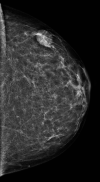WHAT CAN WE ACTUALLY SEE USING COMPUTER AIDED DETECTION IN MAMMOGRAPHY?
- PMID: 34285427
- PMCID: PMC8253062
- DOI: 10.20471/acc.2020.59.04.02
WHAT CAN WE ACTUALLY SEE USING COMPUTER AIDED DETECTION IN MAMMOGRAPHY?
Abstract
The main goal of this study was to compare the results of computer aided detection (CAD) analysis in screening mammography with the results independently obtained by two radiologists for the same samples and to determine the sensitivity and specificity of CAD for breast lesions. A total of 436 mammograms were analyzed with CAD. For each screening mammogram, the changes in breast tissue recognized by CAD were compared to the interpretations of two radiologists. The sensitivity and specificity of CAD for breast lesions were calculated using contingency table. The sensitivity of CAD for all lesions was 54% and specificity 16%. CAD sensitivity for suspicious lesions only was 86%. CAD sensitivity for microcalcifications was 100% and specificity 45%. CAD mainly 'mistook' glandular parenchyma, connective tissue and blood vessels for breast lesions, and blood vessel calcifications and axillary folds for microcalcifications. In this study, we confirmed CAD as an excellent tool for recognizing microcalcifications with 100% sensitivity. However, it should not be used as a stand-alone tool in breast screening mammography due to the high rate of false-positive results.
Keywords: Breast neoplasm; CAD sensitivity; CAD specificity; Computer aided detection (CAD); Image interpretation computer-assisted; Mammography.
Figures
References
-
- Brkljacic B, Miletic D, Sardanelli F. Thermography is not a feasible method for breast cancer screening. Coll Antropol. 2013;2:589–93. - PubMed
MeSH terms
LinkOut - more resources
Full Text Sources
Medical
Miscellaneous

